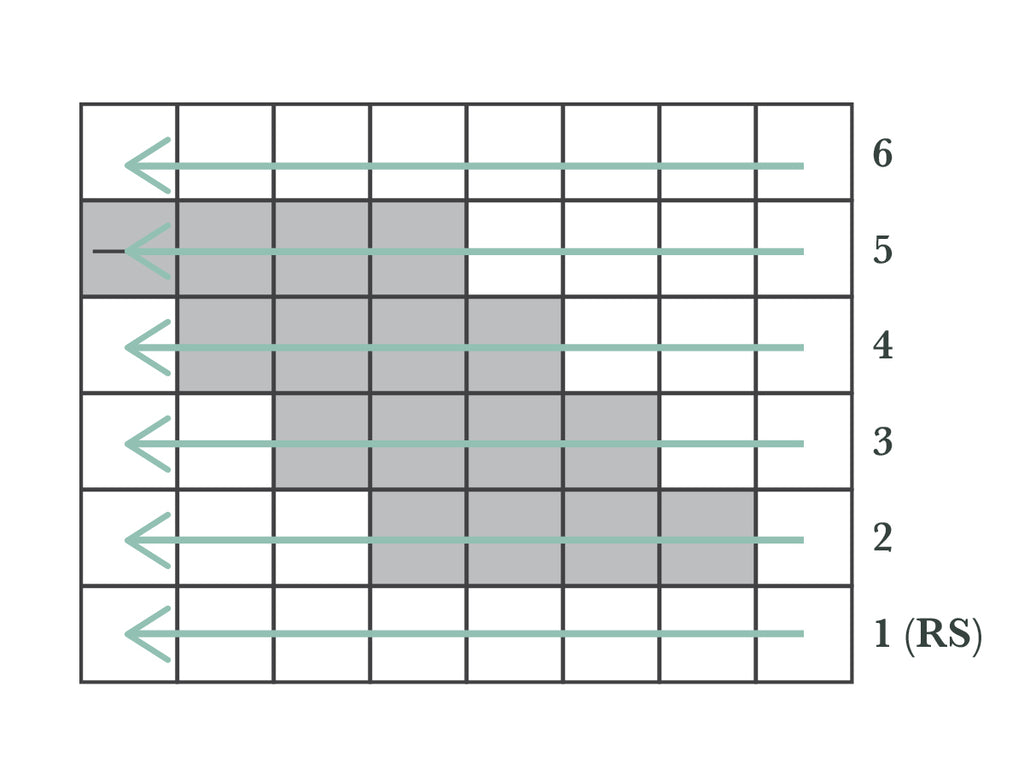
Part 1 of 4: Working From Charts: Knit/Purl Patterning.
We highly recommend you try to familiarize yourself with how charts work. charts are a great tool, and once you’ve swatched and are more familiar with the pattern, you may find that knitting from a charts is a walk in the park!Knitting charts are read from the bottom up. charts that feature knit / purl patterning may either be worked in the round, or back and forth in rows.
Working in Rounds:
For all charts, all rounds are charted and all rounds are RS. When working in the round, you will read all rounds from right to left.

When working in flat in rows, if both RS and WS rows are charted, you will read RS rows from right to left and WS rows from left to right. If WS rows are not charted, there will be separate written instructions telling you what to do on the WS rows.
Note: Typically, RS rows are odd numbered rows, and WS rows are even numbered rows. This is not always the case, though, so it is important to pay attention to which rows are RS, and which are WS.

IMPORTANT NOTE: When looking at the charts, regardless of whether or not you are working flat or in rounds, the charts is a visual representation of what your knitting looks like from the RIGHT SIDE.
Reading charts Keys:
There are only two symbols in Knit/Purl charts, the Knit and the Purl. These stitches represent slightly different things if you are working either in Rows or Rounds.


Row 1 (RS): *P1, k1, p2, k2, p2, k1, p1, k1, p2, k2, p2, k1, p1; rep from * to end.
Row 2 (WS): *P3, k2, p2, k2, p1, k2, p2, k2, p3; rep from * to end.
Row 3: *P2, k2, p2, k2, p3, k2, p2, k2, p2; rep from * to end.
Row 4: *P1, k2, p2, k2, p5, k2, p2, k2, p1; rep from * to end.
Repeat Rows 1-4 for pattern.
Reading a charts in Rounds:
If the same charts from above is in ROUNDS, you would work all rounds from right to left as follows:
Round 1 (RS): *P1, k1, p2, k2, p2, k1, p1, k1, p2, k2, p2, k1, p1; rep from * to end.
Round 2: *K3, p2, k2, p2, k1, p2, k2, p2, k3; rep from * to end.
Round 3: *P2, k2, p2, k2, p3, k2, p2, k2, p2; rep from * to end.
Round 4: *K1, p2, k2, p2, k5, p2, k2, p2, k1; rep from * to end.
Repeat Rounds 1-4 for pattern.
As you can see, while Rows/Rounds 1 and 3 are the same regardless of whether or not you are working in Rows or Rounds, the difference occurs in Rows/Rounds 2 and 4. As mentioned above (and worth repeating), regardless of whether or not you are working flat or in rounds, the charts is a visual representation of what your knitting looks like from the right side. As a result, when working in rows on the WS, a knit will appear as a purl on the RS, and a purl will appear as a knit on the RS. If you look closely at the written instructions for both charts, Round 2 of the charts worked in Rounds (the bottom charts), is the opposite of Row 2 of the charts worked in Rows (the top charts). This is why the key for the blank square is “K on RS, P on WS”, because by purling on the WS, you create a stitch that appears as a knit on the RS.
Working charts Repeats:
While the charts above are within the same repeat (all the stitches represented are within the * and ; that identify the repeat), on some occasions – especially when working back and forth – there are stitches on a charts that are within a repeat, and other stitches that are not.
Below is a Knit/Purl charts with repeat lines. There are a total of 15 stitches represented within the charts, 8 within the repeat and 7 outside of the repeat. 
If the charts was worked in ROWS, right side rows are worked from right to left and wrong side rows are worked from left to right as follows:
Row 1 (RS): P1, k1, p1, *k8; rep from * to 4 sts rem, k1, p1, k1, p1.
Row 2 (WS): K1, p1, k1, p1 *p3, k4, p1; rep from * to 3 sts rem, k1, p1, k1.
Row 3: P1, k1, p1, *k2, p4, k2; rep from * to 4 sts rem, k1, p1, k1, p1.
Row 4: K1, p1, k1, p1 *p1, k4, p3; rep from * to 3 sts rem, k1, p1, k1.
Row 5: P1, k1, p1, *k4, p4; rep from * to 4 sts rem, k1, p1, k1, p1.
Row 6: K1, p1, k1, p1 *p8; rep from * to 3 sts rem, k1, p1, k1.
Repeat Rows 1-6 for pattern.
Below is the same charts as if it was worked in rounds.
Since the charts is in ROUNDS, all rounds are worked from right to left as follows:
Round 1 (RS): P1, k1, p1, *k8; rep from * to 4 sts rem, k1, p1, k1, p1.
Round 2: P1, k1, p1, *k1, p4, k3; rep from * to 4 sts rem, k1, p1, k1, p1.
Round 3: P1, k1, p1, *k2, p4, k2; rep from * to 4 sts rem, k1, p1, k1, p1.
Round 4: P1, k1, p1, *k3, p4, k1; rep from * to 4 sts rem, k1, p1, k1, p1.
Round 5: P1, k1, p1, *k4, p4; rep from * to 4 sts rem, k1, p1, k1, p1.
Round 6: P1, k1, p1, *k8; rep from * to 4 sts rem, k1, p1, k1, p1.
Repeat Rounds 1-6 for pattern.
While many of the same principles outlined above apply to colorwork, cable, and lace knitting from charts, each has a few separate key points worth highlighting.
